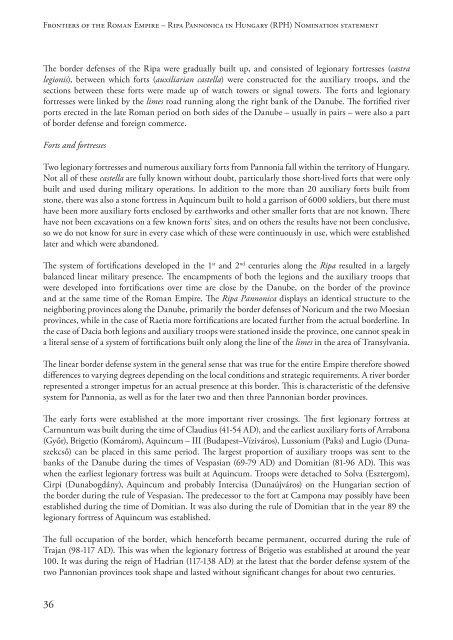the PDF version! - Danube Limes
the PDF version! - Danube Limes
the PDF version! - Danube Limes
You also want an ePaper? Increase the reach of your titles
YUMPU automatically turns print PDFs into web optimized ePapers that Google loves.
Frontiers of <strong>the</strong> Roman Empire – Ripa Pannonica in Hungary (RPH) Nomination statement<br />
The border defenses of <strong>the</strong> Ripa were gradually built up, and consisted of legionary fortresses (castra<br />
legionis), between which forts (auxiliarian castella) were constructed for <strong>the</strong> auxiliary troops, and <strong>the</strong><br />
sections between <strong>the</strong>se forts were made up of watch towers or signal towers. The forts and legionary<br />
fortresses were linked by <strong>the</strong> limes road running along <strong>the</strong> right bank of <strong>the</strong> <strong>Danube</strong>. The fortified river<br />
ports erected in <strong>the</strong> late Roman period on both sides of <strong>the</strong> <strong>Danube</strong> – usually in pairs – were also a part<br />
of border defense and foreign commerce.<br />
Forts and fortresses<br />
Two legionary fortresses and numerous auxiliary forts from Pannonia fall within <strong>the</strong> territory of Hungary.<br />
Not all of <strong>the</strong>se castella are fully known without doubt, particularly those short-lived forts that were only<br />
built and used during military operations. In addition to <strong>the</strong> more than 20 auxiliary forts built from<br />
stone, <strong>the</strong>re was also a stone fortress in Aquincum built to hold a garrison of 6000 soldiers, but <strong>the</strong>re must<br />
have been more auxiliary forts enclosed by earthworks and o<strong>the</strong>r smaller forts that are not known. There<br />
have not been excavations on a few known forts’ sites, and on o<strong>the</strong>rs <strong>the</strong> results have not been conclusive,<br />
so we do not know for sure in every case which of <strong>the</strong>se were continuously in use, which were established<br />
later and which were abandoned.<br />
The system of fortifications developed in <strong>the</strong> 1 st and 2 nd centuries along <strong>the</strong> Ripa resulted in a largely<br />
balanced linear military presence. The encampments of both <strong>the</strong> legions and <strong>the</strong> auxiliary troops that<br />
were developed into fortifications over time are close by <strong>the</strong> <strong>Danube</strong>, on <strong>the</strong> border of <strong>the</strong> province<br />
and at <strong>the</strong> same time of <strong>the</strong> Roman Empire. The Ripa Pannonica displays an identical structure to <strong>the</strong><br />
neighboring provinces along <strong>the</strong> <strong>Danube</strong>, primarily <strong>the</strong> border defenses of Noricum and <strong>the</strong> two Moesian<br />
provinces, while in <strong>the</strong> case of Raetia more fortifications are located fur<strong>the</strong>r from <strong>the</strong> actual borderline. In<br />
<strong>the</strong> case of Dacia both legions and auxiliary troops were stationed inside <strong>the</strong> province, one cannot speak in<br />
a literal sense of a system of fortifications built only along <strong>the</strong> line of <strong>the</strong> limes in <strong>the</strong> area of Transylvania.<br />
The linear border defense system in <strong>the</strong> general sense that was true for <strong>the</strong> entire Empire <strong>the</strong>refore showed<br />
differences to varying degrees depending on <strong>the</strong> local conditions and strategic requirements. A river border<br />
represented a stronger impetus for an actual presence at this border. This is characteristic of <strong>the</strong> defensive<br />
system for Pannonia, as well as for <strong>the</strong> later two and <strong>the</strong>n three Pannonian border provinces.<br />
The early forts were established at <strong>the</strong> more important river crossings. The first legionary fortress at<br />
Carnuntum was built during <strong>the</strong> time of Claudius (41-54 AD), and <strong>the</strong> earliest auxiliary forts of Arrabona<br />
(Győr), Brigetio (Komárom), Aquincum – III (Budapest–Víziváros), Lussonium (Paks) and Lugio (Dunaszekcső)<br />
can be placed in this same period. The largest proportion of auxiliary troops was sent to <strong>the</strong><br />
banks of <strong>the</strong> <strong>Danube</strong> during <strong>the</strong> times of Vespasian (69-79 AD) and Domitian (81-96 AD). This was<br />
when <strong>the</strong> earliest legionary fortress was built at Aquincum. Troops were detached to Solva (Esztergom),<br />
Cirpi (Dunabogdány), Aquincum and probably Intercisa (Dunaújváros) on <strong>the</strong> Hungarian section of<br />
<strong>the</strong> border during <strong>the</strong> rule of Vespasian. The predecessor to <strong>the</strong> fort at Campona may possibly have been<br />
established during <strong>the</strong> time of Domitian. It was also during <strong>the</strong> rule of Domitian that in <strong>the</strong> year 89 <strong>the</strong><br />
legionary fortress of Aquincum was established.<br />
The full occupation of <strong>the</strong> border, which henceforth became permanent, occurred during <strong>the</strong> rule of<br />
Trajan (98-117 AD). This was when <strong>the</strong> legionary fortress of Brigetio was established at around <strong>the</strong> year<br />
100. It was during <strong>the</strong> reign of Hadrian (117-138 AD) at <strong>the</strong> latest that <strong>the</strong> border defense system of <strong>the</strong><br />
two Pannonian provinces took shape and lasted without significant changes for about two centuries.<br />
36











